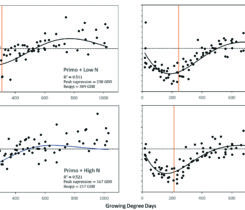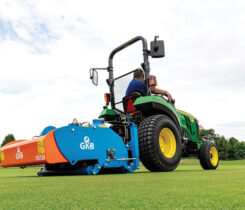Improving PGRs by degrees
We all improve our turf skills by degrees. One way to improve effective use of PGRs is by tracking growing degree days.
Growing degree days (GDD) are figured by taking the average of the daily maximum and minimum temperatures compared to a base temperature. Don’t worry about the math – there are several turf-friendly online resources that will do the job for you.
“Nature does not work on calendar dates but on temperatures,” says Doug Soldat, soil scientist at the University of Wisconsin-Madison. “An increase in temperatures of about 20 degrees cuts the half-life of a Primo Maxx in half.” University of Illinois researchers showed that the half-life of Primo Maxx at 64F degrees is 6.4 days. Apply the same material at 86F degrees and half the material disappears in just 3.1 days.
“If it is warm, you should ask yourself if you should be applying growth regulators more frequently,” Soldat advises superintendents. The short answer is likely yes. However, there are nuances. Ignoring those nuances can be costly in terms of real dollars.
Optimizing PGRs
“The best time to re-apply a PGR is when the turf starts to come out of its period of maximum growth regulation,” Soldat says. Typically, the tipping point between suppression and rebound for bentgrass is somewhere around 300 GDD for Primo Maxx.
As a rule of thumb, Primo should be applied every time the number of GDDs reaches 200.
Trimmit tends to give more and longer lasting suppression. For that reason, with Trimmit the optimum GDD figure is 300 days.
In test plots, the researchers sprayed Primo every 800, 400, 200 and 100 GDDs. For reference, 800 GDD is about once every two months in Wisconsin conditions. They found no real difference between spraying at 800 GDD and 400 GDD intervals. In both cases, suppression was not acceptable.
“At 200 and 100 GDD we were able to keep growth lower than the control for the entire season,” Soldat says.
Note that research shows that applying PGRs on creeping bentgrass gives only 10 to 20 percent suppression, even under the more frequent treatment routines. This is well below the 50 percent suppression found with other grasses.
“While the concept probably will translate to other species, the appropriate re-application interval may be quite different,” Soldat cautions.
The research also demonstrates that re-application intervals vary with the time of year and seasonal temperature fluctuations.
In the Spring and Fall, it may take as long as three weeks to reach 200 GDD. In the Summer, re-application of Primo may be required every seven to 10 days.
Other considerations
In his research, Soldat found that doubling the rate of Primo Maxx to one-quarter ounce (from one-eighth ounce) per 1000 square feet, “made absolutely no difference in the amount or duration of growth suppression,” Soldat says.
Going to a quarter-ounce is a waste, Soldat adds. In fact, he wonders whether a rate below one-eighth ounce would be equally as effective. This is because Primo is absorbed by the plant’s foliage and crown. Low mowing heights may mean that superintendents are applying more material than the plant can absorb as the mower cuts to 0.25 or 0.125 inches.
“When you mow grass higher, it grows a lot slower than when you drop the mower,” Soldat points out. “Remember that raising the mower decreases stress on the plant.”
For that reason, if there are collar problems, dropping the mower height and shaving them close will result in faster growth for the grass there and can help to recover from wear damage.
For the same reason, Primo is more effective on taller grass.
Do PGRs increase Poa annua encroachment on greens? The handful of research studies are split on the answer. In one case, research showed that, with Primo, there was 17 to 18 percent Poa and without there was 22 percent. The feeling was that annual bluegrass may be regulated more by PGRs than creeping bent.
In one informal test, superintendents underestimated the presence of Poa in greens by half. “Perhaps when you use Primo, it makes the Poa easier to see,” Soldat speculates.
Better visual quality of the grass may be the result of multi-year use of Primo. Since you are growing less grass, you are removing less grass and more N is in the soil. “It takes a while for the N to accumulate in the soil,” Soldat says.
In fact, with frequent use of Primo, researchers got equally good grass using 0.2 pounds N per 1000 square feet every 14 as they did with 0.4 pounds N on greens without Primo.
“Primo reduced the N requirements by 30 to 50 percent,” Soldat says. However, he adds, “I’m not saying to adjust your N fertility. But it is something to think about.”
Primo had no effect on phosphorus requirements.
How GDDs work
One key fact to keep in mind is that the GDD calculator for PGRs is calibrated in Centigrade and not Fahrenheit degrees. If you are calculating by hand, that is an important difference. However, if you are using the on-line tool, the calculation from Fahrenheit to Centigrade is done automatically.
For purposes of calculating GDD for growth regulators, the baseline for GDD should be reset to zero every time an application is made. So, in warmer weather, the PGR GDD clock for Primo may be reset to zero about every 10 days.
Researchers arrived at those figures after repeatedly going through the laborious process of collecting and cleaning clippings from a number of putting greens. Every grain of sand had to be removed by hand to assure accurate figures.
Save yourself a lot of hassle. The bottom line, Soldat says, “If you are using Primo on a green you should be using a 200-GDD model. If you cannot reapply every 200 GDDs, maybe you should not be using Primo.”











